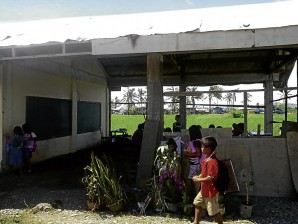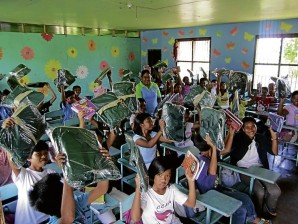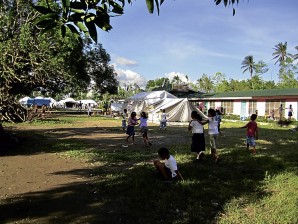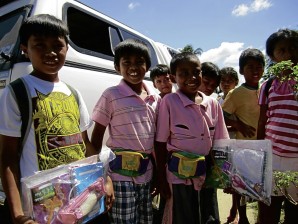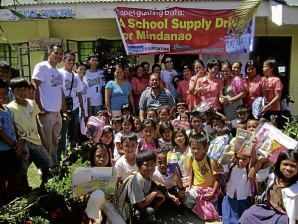Post-‘Pablo’ report: Education in need of aid
The best laid plans of men, never mind the mice, often go awry.
Promencio O. Palmares, principal of Tamia Elementary School (TES) in Barangay (village) Tamia, Compostela, Compostela Valley (ComVal), realized this after Typhoon “Pablo” struck on Dec. 4, leaving his school with just the debris of two buildings and reducing one classroom to a virtual skeleton.
In the improvement plan for school year 2013-14 that he had submitted a month earlier to the Division of Compostela Valley in the Department of Education’s (DepEd) Region 11, Palmares said the school’s nine buildings had enough classrooms for its student population of less than 600, although three needed major repairs and one, just minor repairs. Spoken too soon, as it turned out.
At the time of this visit, most of the province itself was still reeling from shock, not just because of the number of lives lost and the amount of property damaged but also because it was apparently the first time the locals experienced winds of the speed and force brought by Pablo.
“Floods are regular occurrences. But we were not prepared for the strong wind,” said Palmares, who finished the first four grades of his schooling at TES, which started in 1958 as a
Article continues after this advertisementprimary school.
Article continues after this advertisementThe sentiment was echoed by teachers at Mangayon National High School (MNHS) in Barangay Mangayon. Although perched on a hill and in no danger of flooding, its staff and
students all come from low-lying areas.
Eleuterio R. Saberon, a mathematics teacher who is also in charge of the computer laboratory, said: “It rains here from December to January but there is no typhoon. Residents are used to the floods.”
Some residents of Barangay Andap over in New Bataan are convinced it was not just an ordinary typhoon that hit them but a tornado. Andap has virtually been wiped out by huge boulders carried by the violent wind and floodwaters that resulted in scores of villagers dying or missing.
“The wind was like a screwdriver, moving in a circular motion and boring holes in the ground,” one local said. He added that some elders said the last time devastation of the magnitude wrought by Pablo occurred was about a century ago.
Six elementary schools were reportedly wiped out in Andap. At the time of this visit, all classes were being held at the last high school standing.
For the schools and their students, the calamity further strained already stretched-to-the-limit resources.
Palmares’ office in TES had now become the storage area for sacks of rice used in the school feeding program. To keep the sacks dry, they were stacked on top of tables, teaching materials and books pushed to the corners.
In Mangayon, the building where the office of principal Janelita
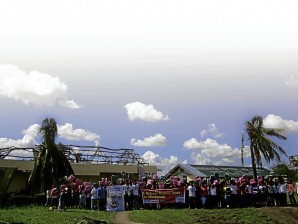
THE ROOFLESS building in the background is a reminder of the reason for the visit to MNHS of the Inquirer Learning section and InqCare.
V. Maratas, the faculty room and computer laboratory were located was now crowned by twisted metals that used to hold the roof.
All 23 computers in the lab were exposed to the elements and, Saberon said, they could not even check if they were still working because, two months to the date, power had not been restored to the typhoon-hit areas.
In both TES and MNHS where, like in many public schools, primary requirements were barely enough, books and other educational tools were lost and/or damaged by the typhoon.
Other schools could not even start on rehabilitation, as evacuees, with nowhere to go back to, continued to occupy their premises.
Some schools in the town of New Bataan, which was hit hardest by Pablo, still looked like campsites, as grounds were filled with tents providing temporary shelter to typhoon victims.
In these areas, students might not have lost personal belongings at school but, with their own homes devastated, whatever little they had in terms of school supplies were gone, too.
Reports from Davao Oriental were even more dismal, as some villages remained unreachable.
Of the 617 classrooms in Davao Oriental’s districts of Boston, Cateel I, Cateel II, Baganga North and Baganga South, only 173 were available after the typhoon, according to an update issued on Jan. 22 by the DepEd.
The report on the distribution of tents and available temporary learning spaces also said that in Compostela Valley, only 980 classrooms were available out of 1,326 in the districts of New Bataan, Compostela, Montevista, Laak, Monkayo and Maragusan.
Tents and tarpaulins from the DepEd’s central office and various international donor organizations provided a total of 1,494 temporary learning spaces, of which 463 were in Oriental and 1,031 in ComVal, where 30 classes were held in two shifts.
An evaluation made a month earlier, based on partial reports submitted to the DepEd’s Rapid Disaster Assessment Report, placed damage to school sites, facilities and classrooms in
Regions 10, 11, Caraga and the Autonomous Region in Muslim Mindanao at P1,049,088,620.
Region 11, which bore the brunt of Pablo’s fury, accounted for about 72 percent of the total, with damage estimated at P753,528,000. Davao Oriental reported damage to 129 school sites at an estimated cost of P591,723,000. ComVal estimated damage to 127 sites at P151,055,000.
Clearly, education in these places is in dire need of aid.
